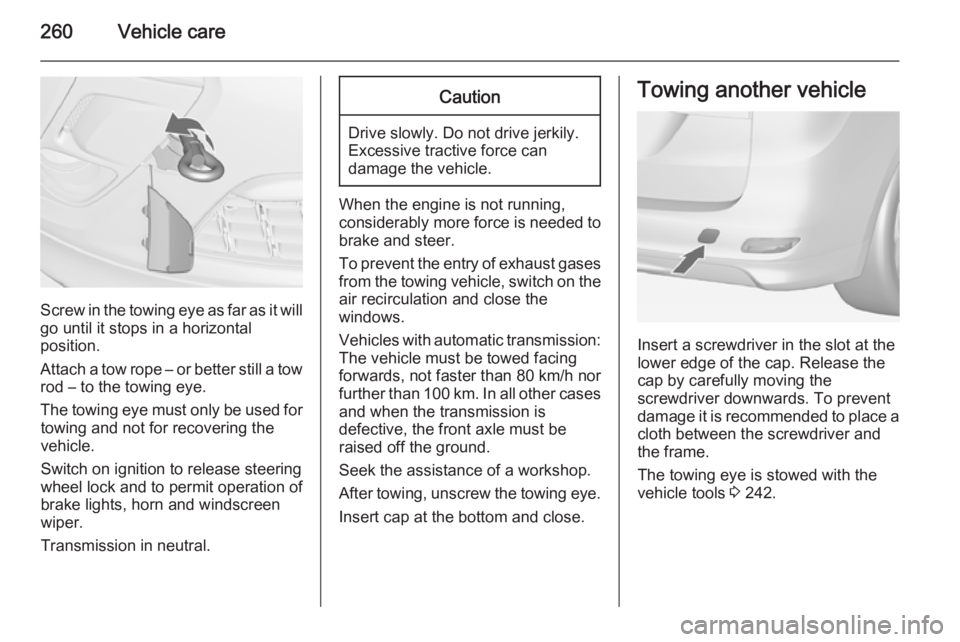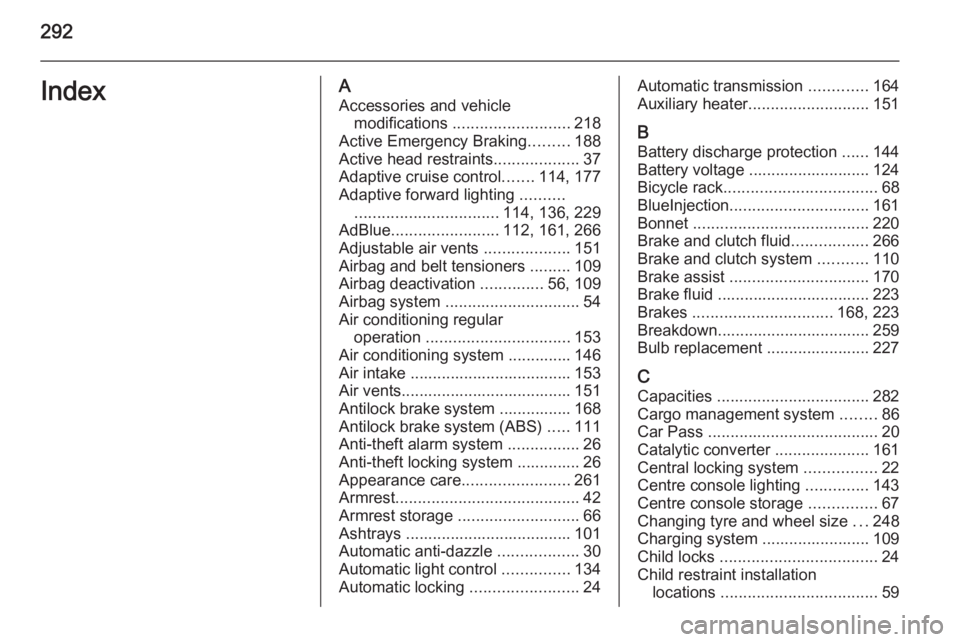Page 260 of 299

258Vehicle careJump startingDo not start with quick charger.
A vehicle with a discharged battery
can be started using jump leads and the battery of another vehicle.9 Warning
Be extremely careful when starting
with jump leads. Any deviation
from the following instructions can
lead to injuries or damage caused
by battery explosion or damage to the electrical systems of both
vehicles.
9 Warning
Avoid contact of the battery with
eyes, skin, fabrics and painted
surfaces. The fluid contains
sulphuric acid which can cause
injuries and damage in the event
of direct contact.
■ Never expose the battery to naked flames or sparks.
■ A discharged battery can alreadyfreeze at a temperature of 0 °C.
Defrost the frozen battery before
connecting jump leads.
■ Wear eye protection and protective
clothing when handling a battery.
■ Use a booster battery with the same voltage (12 Volts). Its
capacity (Ah) must not be much less than that of the discharged
battery.
■ Use jump leads with insulated terminals and a cross section of at
least 16 mm 2
(25 mm 2
for diesel
engines).
■ Do not disconnect the discharged battery from the vehicle.
■ Switch off all unnecessary electrical
consumers.
■ Do not lean over the battery during jump starting.
■ Do not allow the terminals of one lead to touch those of the other
lead.
■ The vehicles must not come into contact with each other during the
jump starting process.■ Apply the parking brake, transmission in neutral, automatictransmission in P.
■ Open the positive terminal protection caps of both batteries.
Lead connection order:
1. Connect the red lead to the positive terminal of the booster
battery.
2. Connect the other end of the red lead to the positive terminal of the
discharged battery.
Page 262 of 299

260Vehicle care
Screw in the towing eye as far as it will
go until it stops in a horizontal
position.
Attach a tow rope – or better still a tow
rod – to the towing eye.
The towing eye must only be used for towing and not for recovering the
vehicle.
Switch on ignition to release steering
wheel lock and to permit operation of
brake lights, horn and windscreen
wiper.
Transmission in neutral.
Caution
Drive slowly. Do not drive jerkily.
Excessive tractive force can
damage the vehicle.
When the engine is not running,
considerably more force is needed to
brake and steer.
To prevent the entry of exhaust gases from the towing vehicle, switch on the
air recirculation and close the
windows.
Vehicles with automatic transmission: The vehicle must be towed facing
forwards, not faster than 80 km/h nor further than 100 km. In all other cases
and when the transmission is
defective, the front axle must be
raised off the ground.
Seek the assistance of a workshop.
After towing, unscrew the towing eye.
Insert cap at the bottom and close.
Towing another vehicle
Insert a screwdriver in the slot at the
lower edge of the cap. Release the
cap by carefully moving the
screwdriver downwards. To prevent
damage it is recommended to place a cloth between the screwdriver and
the frame.
The towing eye is stowed with the vehicle tools 3 242.
Page 279 of 299
Technical data277PerformanceEngineB14NELB14NET
B14NET
LPGB16XNT
CNGMaximum speed 3)
[km/h]Manual transmission
with Stop-start system190
192200
202195
–200
–Automatic transmission–197––3) The maximum speed indicated is achievable at kerb weight (without driver) plus 200 kg payload. Optional equipment could reduce the specified maximum
speed of the vehicle.EngineA16SHTA16XHTA18XELA18XERMaximum speed 3)
[km/h]Manual transmission
with Stop-start system–
225–
–185
–195
–Automatic transmission–208––3) The maximum speed indicated is achievable at kerb weight (without driver) plus 200 kg payload. Optional equipment could reduce the specified maximum
speed of the vehicle.
Page 280 of 299
278Technical dataEngineB16DTHB16DTJA20DTLA20DT
A20DTH
121 kWA20DTH
96 kW
A20DTR
Maximum speed 3)
[km/h]Manual transmission
with Stop-start system–
193–
186183
–191
193208
209–
––
218Automatic transmission––––205192–3) The maximum speed indicated is achievable at kerb weight (without driver) plus 200 kg payload. Optional equipment could reduce the specified maximum
speed of the vehicle.
Page 281 of 299
Technical data279Vehicle weight
Kerb weight, basic model without any optional equipmentEngineManual transmissionAutomatic transmission5-seats/7-seats
[kg]B14NEL1613/1640–B14NET1613/16401613/1640B14NET LPG1664/1691–A16SHT1664/1691–B16XNT CNG1701/1728–A16XHT1664/16911664/1691A18XEL1571/1598–A18XER1571/1598–
Optional equipment and accessories increase the kerb weight.
Loading information 3 92.
Page 282 of 299
280Technical data
EngineManual transmissionAutomatic transmission5-seats/7-seats
[kg]B16DTH1701/1728–B16DTJ1701/1728–A20DTL1701/1728–A20DT1701/1728–A20DTH
121 kW1733/17601733/1760A20DTH
96 kW–1733/1760A20DTR1733/1760–
Optional equipment and accessories increase the kerb weight.
Loading information 3 92.
Vehicle dimensionsZafira TourerLength [mm]4656Width without exterior mirrors [mm]1884Width with two exterior mirrors [mm]2100Height (without antenna) [mm]1685
Page 294 of 299

292IndexAAccessories and vehicle modifications .......................... 218
Active Emergency Braking .........188
Active head restraints ...................37
Adaptive cruise control .......114, 177
Adaptive forward lighting ..........
................................ 114, 136, 229
AdBlue ........................ 112, 161, 266
Adjustable air vents ...................151
Airbag and belt tensioners .........109
Airbag deactivation ..............56, 109
Airbag system .............................. 54
Air conditioning regular operation ................................ 153
Air conditioning system .............. 146
Air intake .................................... 153
Air vents...................................... 151
Antilock brake system ................ 168
Antilock brake system (ABS) .....111
Anti-theft alarm system ................26
Anti-theft locking system .............. 26
Appearance care ........................261
Armrest ......................................... 42
Armrest storage ........................... 66
Ashtrays ..................................... 101
Automatic anti-dazzle ..................30
Automatic light control ...............134
Automatic locking ........................24Automatic transmission .............164
Auxiliary heater ........................... 151
B
Battery discharge protection ......144
Battery voltage ........................... 124
Bicycle rack .................................. 68
BlueInjection ............................... 161
Bonnet ....................................... 220
Brake and clutch fluid .................266
Brake and clutch system ...........110
Brake assist ............................... 170
Brake fluid .................................. 223
Brakes ............................... 168, 223
Breakdown.................................. 259
Bulb replacement ....................... 227
C Capacities .................................. 282
Cargo management system ........86
Car Pass ...................................... 20
Catalytic converter .....................161
Central locking system ................22
Centre console lighting ..............143
Centre console storage ...............67
Changing tyre and wheel size ...248
Charging system ........................ 109
Child locks ................................... 24
Child restraint installation locations ................................... 59
Page:
< prev 1-8 9-16 17-24